2019 Building America Report Menu
Our
Economic Impact
Union Pacific exists to build America. Our positive economic impact is more than just a by-product of our business; it’s central to our vision and purpose.
Our railroad connects communities and resources, generating opportunity and supporting growth in the 23 states where we operate and across the country. We create economic value not only through returns generated for shareholders, but also employment for approximately 37,500 employees, the business we give suppliers, and every business opportunity, commercial relationship and innovative idea our network makes possible.
- Investing in Infrastructure
- Connecting People, Markets and Economies
- Creating Local Economic Opportunity
- Enabling Innovation and Sustainability
- Generating Opportunity Through Our Supply Chain
- What's Ahead
Unloading components to build a wind turbine farm near Des Moines, Iowa.
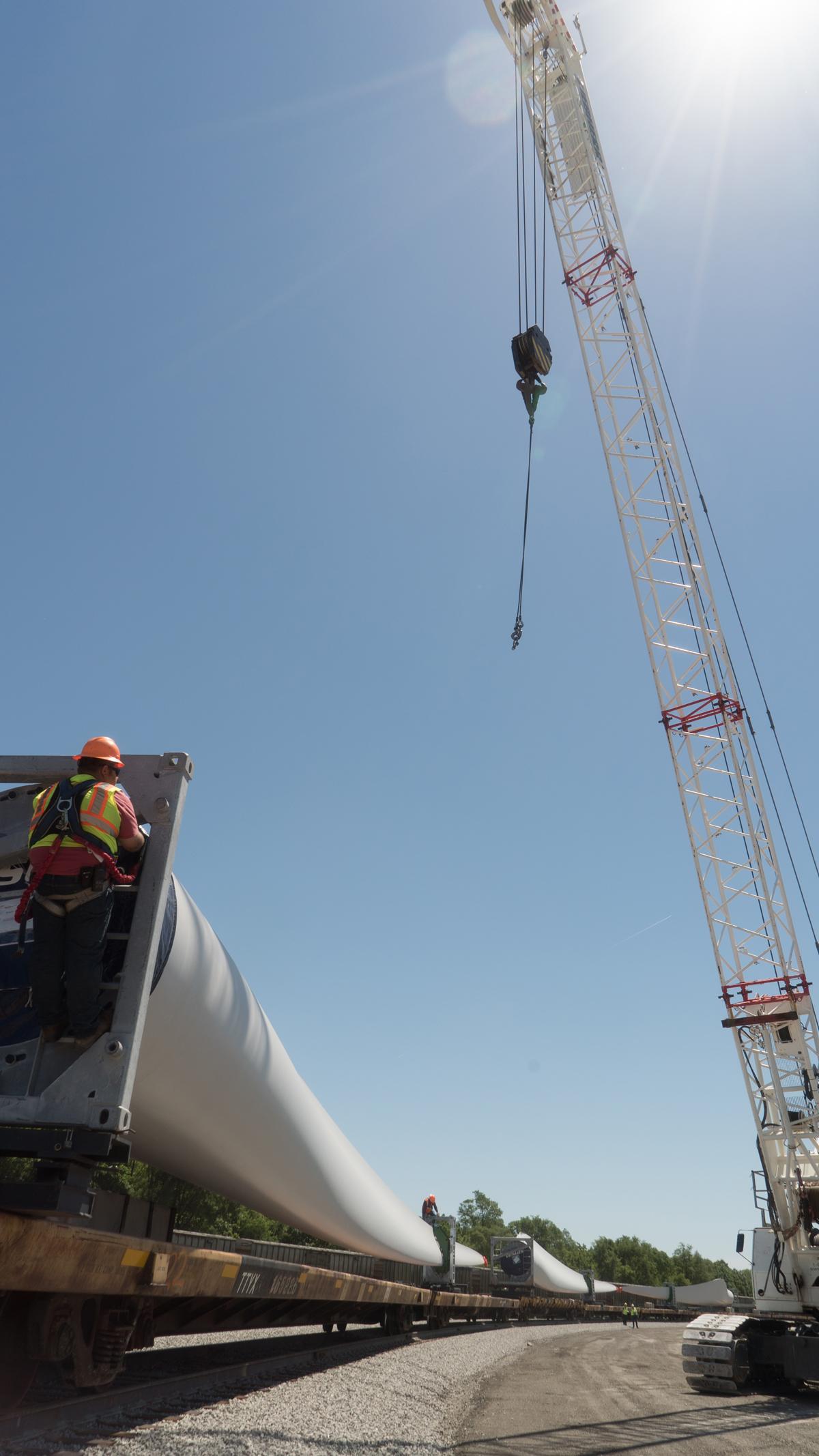
Investing in Infrastructure
Union Pacific’s capital investments create economic opportunity through employment and supply chain activity. They also represent investments in building a rail network that supports sustainable economic growth for generations to come.
Union Pacific’s capital program totaled $3.2 billion. The more we invest in building a safe and efficient railroad today, the better our infrastructure can support communities going forward. By 2045, U.S. freight shipments will increase by more than 40% and America’s population will grow by 70 million.1 Union Pacific has capacity to safely and reliably move additional goods, decreasing truck congestion on the nation’s already jammed highways and interstates.
Our capital investment efforts combined with our Unified Plan 2020 initiative provide customers the opportunity to grow, boosting the local, regional and national economy. The chart on this page shows the level of capital investments Union Pacific made in 2019.
Infrastructure Replacement
Our largest form of capital investment strengthens our rail network through track, signal and bridge replacement projects.
Locomotives And Equipment
New and upgraded locomotives, rail cars and equipment investments meet customer needs, enhance safety and reduce our environmental impact.
Capacity And Commercial Facilities
New commercial facilities and network expansions increase our capacity to support economic growth and opportunities to serve new locations.
Positive Train Control (PTC)
This advanced system of technologies is designed to automatically stop a train before certain accidents occur, such as train-to-train collisions and incidents caused by excessive speed or unauthorized movements.
1 Source: U.S. Federal Highway Administration
Innovation
From apps managing train systems to enhanced track inspection programs, we continually invest in new technologies enhancing safety, efficiency and service.
New Sidings Expand Sunset Capacity
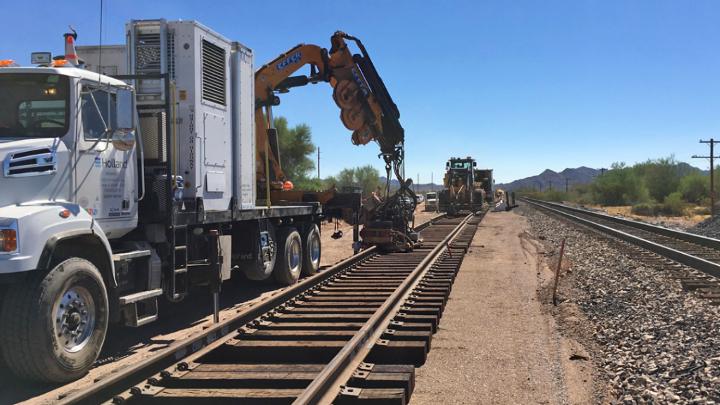
Engineering teams weld track panels on the Sunset Route.
Five new siding extensions support smooth sailing for our customers’ goods across the Sunset Route. The line carries roughly 20% of Union Pacific’s traffic, serving as a gateway from Los Angeles, California, to the east through Arizona and New Mexico. Engineering crews installed 6,500 concrete ties and 950 track panels, and made 2,500 welds to complete the siding projects. A siding is like a passing lane, the track runs parallel to the main line with switches at both ends, allowing trains to meet and pass. Each extension averaged 7,000-7,500 feet in length, accommodating longer train lengths to support Unified Plan 2020 and efforts to reduce greenhouse gas (GHG) emissions by operating fewer locomotives. Longer sidings allow us to be more strategic with train meets, reducing main line congestion and delays. For our customers, it means service reliability.
Intermodal Facility Gets LA-Style Makeover
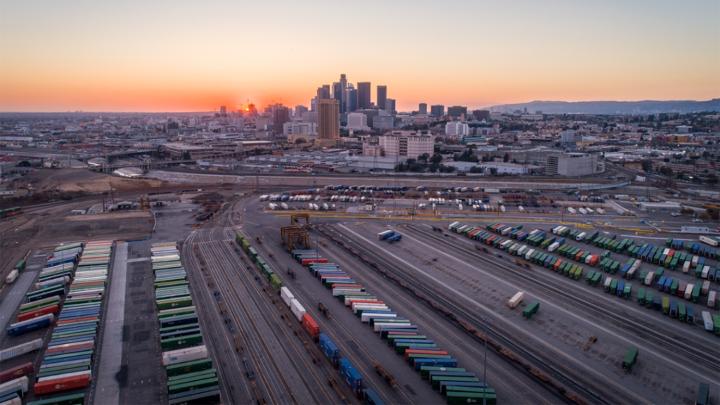
LATC Intermodal Facility sits on 145 acres in downtown Los Angeles, California.
The Los Angeles Transportation Center (LATC) Intermodal Facility is undergoing a multi-million-dollar facelift, modernizing the yard. The updates, which include reconfiguring thousands of feet of track, will significantly improve fluidity, capacity and production. While new track is going in, contractors grade the area and work on lighting and building construction. We’re also making it easier for our customers to get into the facility through an automatic gate system, and we’re adding more than 200 parking spots. These updates will help customers pick up containers faster, reducing dwell. The project is expected to be finished in fall 2020.
60%

$1,950 M
Infrastructure Replacement
10%
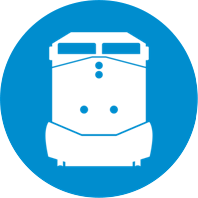
$320 M
Locomotives & Equipment
17%

$540 M
Capacity & Commercial Facilities
3%

$95 M
Positive Train Control (PTC)
10%

$330 M
Technology and Other
Connecting People, Markets and Economies
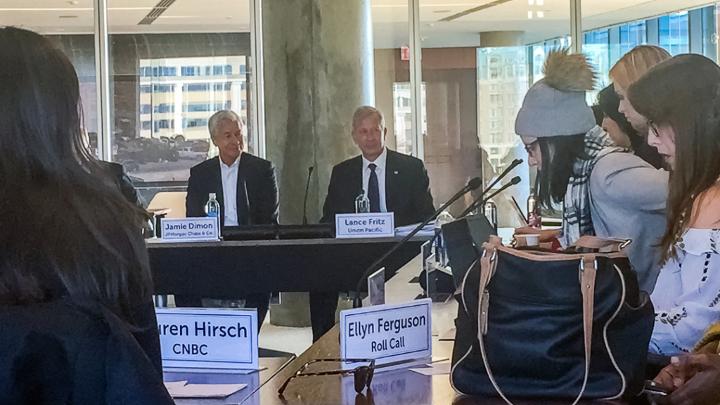
Chairman Lance Fritz and JPMorgan Chase CEO Jamie Dimon met with reporters in Washington, D.C., to announce the Business Roundtable’s USMCA endorsement.
Union Pacific strongly believes robust international trade is critical to America’s economy. Following years of negotiations, significant strides were made in 2019, and we are pleased Congress and the president secured two victories in early 2020 – Congressional ratification of the United States-Mexico-Canada Agreement (USMCA) and a “Phase One” trade deal with China.
Trade with Canada and Mexico supports more than 12 million jobs in the U.S. economy. It drives U.S. export growth, as Canada and Mexico buy one-fifth of everything manufacturers make in America and more U.S.-made goods than our next 11 trading partners combined.
Congressional passage of the USMCA provides the long-term certainty Union Pacific, and other U.S. businesses, need in order to leverage new opportunities in cross-border movements. It also modernizes rules to reflect technological progress and higher standards to level the playing field for job creators in the U.S. It includes enforcement for all issues, including market-opening commitments, stronger protections for our nation’s innovators, and new labor and environmental standards.
There is no doubt Union Pacific’s relationship with and support of pro-rail lawmakers, coordinated with lobbying efforts by the entire business community, played a role in ratification. Chairman, President and CEO Lance Fritz has long been a champion of modernizing our nation’s trade deals. In June, he joined JPMorgan Chase CEO Jamie Dimon, UPS CEO David Abney, Steelcase CEO James Keane and Business Roundtable CEO Joshua Bolten for a meeting with President Trump at the White House, to discuss a number of key policies and economic priorities.
The “Phase One” agreement between the U.S. and China is a step in the right direction. It includes new commitments from China to increase purchases of U.S. agricultural, energy and manufactured goods over the next two years by $200 billion in exchange for a reduction in tariffs imposed on China over the last two years. Most importantly, China agreed to end long-standing unfair trade practices, such as intellectual property theft, forced technology transfer, currency manipulation and discriminatory regulatory barriers that have historically disadvantaged U.S. companies. We’re hopeful that as negotiations continue our nation’s farmers and businesses will benefit and the additional volume will travel by rail.
In the News
Many national news publications featured comments from Chairman, President and CEO Lance Fritz discussing USMCA, tariffs and trade with China.
Fox Business, May 2019
“USMCA is a better deal, modernizing many aspects of NAFTA. That’s a great thing, and at this point, we need to move forward.”
CNBC, June 2019
“The president’s used them [tariffs] as an effective tool to get China to the table, but I think we need to use caution as to how deep and long we use that as a tool because it will definitely create a problem with our economy.”
Yahoo Finance, June 2019
“This is something we can’t screw up. While I know our economy is largely driven by consumers, it is tightly linked to our trading partners. If you think about it this way, we represent 5% of the world's population, 25% of the world's wealth. A lot else is happening outside, and we must have markets available to us.”
Bloomberg, October 2019
“The industrial economy feels like it is slowing down a bit. There is a little more risk aversion, and I think a trade deal would help that; both ratifying USMCA and getting certainty in a comprehensive trade deal with China would help tremendously.”
MSN Money, December 2019
“Free and fair trade agreements are vital to economic prosperity for American workers, families and communities.”
Creating Local Economic Opportunity
Union Pacific owns and operates more than 32,000 track miles in 23 states across the western two-thirds of the U.S. We create economic opportunities for local communities through direct employment with Union Pacific, as well as prosperity created by local employee spending. Our capital investments create additional jobs and business opportunities through our supply chain. The following chart shows Union Pacific’s economic impact in the states where we operate.
| State | Employees | Payroll* | Route Miles | Capital Investment* |
In State Purchases* |
Community Ties Giving Program |
|---|---|---|---|---|---|---|
| Arizona | 1,049 | 95.1 | 691 | 226.7 | 22.8 | 135,600 |
| Arkansas | 2,243 | 208.2 | 1,325 | 47.8 | 40.6 | 546,800 |
| California | 3,849 | 385.4 | 3,365 | 327.7 | 195.7 | 1,984,500 |
| Colorado | 816 | 83.4 | 1,505 | 49.7 | 152.8 | 406,200 |
| Idaho | 756 | 72.4 | 848 | 49.6 | 10.8 | 207,400 |
| Illinois | 3,609 | 343.8 | 2,315 | 103.3 | 1,403.6 | 912,200 |
| Iowa | 1,381 | 129.5 | 1,434 | 85.4 | 47.6 | 679,800 |
| Kansas | 1,054 | 110.5 | 2,199 | 102.0 | 229.9 | 184,000 |
| Louisiana | 1,031 | 112.7 | 1,143 | 83.0 | 37.5 | 301,900 |
| Minnesota | 387 | 39.6 | 645 | 18.0 | 113.0 | 142,600 |
| Missouri | 2,003 | 188.8 | 1,541 | 79.4 | 274.0 | 332,300 |
| Montana | 13 | 1.2 | 125 | 1.6 | 11.5 | 23,800 |
| Nebraska | 7,182 | 947.6 | 1,065 | 358.9 | 193.9 | 7,441,200 |
| Nevada | 488 | 39.7 | 1,192 | 50.7 | 8.9 | 172,500 |
| New Mexico | 486 | 43.4 | 618 | 58.1 | 2.1 | 113,200 |
| Oklahoma | 332 | 34.0 | 1,240 | 56.1 | 116.9 | 137,000 |
| Oregon | 1,232 | 121.5 | 1,073 | 83.8 | 74.3 | 466,300 |
| Other | 165 | 31.2 | 31 | 490.1 | 1,413.3 | 5,279,800 |
| Tennessee | 49 | 4.0 | 17 | 0 | 80.0 | 0 |
| Texas | 6,614 | 594.6 | 6,355 | 754.2 | 1,938.1 | 1,854,900 |
| Utah | 1,157 | 112.3 | 1,269 | 71.3 | 127.5 | 416,800 |
| Washington | 300 | 25.6 | 540 | 24.9 | 154.8 | 144,000 |
| Wisconsin | 351 | 37.0 | 930 | 28.4 | 197.5 | 126,200 |
| Wyoming | 935 | 73.5 | 874 | 55.2 | 56.3 | 165,800 |
| Total | 37,482 | 3,835 | 32,340 | 3,205.9 | 6,903.4 | 22,174,800 |
*In Millions
Enabling Innovation and Sustainability
The rail infrastructure Union Pacific maintains and operates enables growth and innovation. By helping businesses form new partnerships, provide cost-competitive solutions and source new types of raw materials, our network supports the transition toward a more sustainable economy.
If There's Rail Customers Will Come
Two new logistics parks in Texas are providing growth opportunities for businesses that may not have benefited from rail in the past. RCR Hempstead Logistics Park, served exclusively by Union Pacific, is in Northwest Houston and opened in February 2020. Most of the city’s rail business was focused on the east side; however, more than 5 million people live within 100 miles of the new terminal. The developer believes the new park will spur business development, divert thousands of trucks off the road and provide much-needed employment in the region.
In Eagle Pass, Texas, Maverick Industrial Park abuts Union Pacific’s Clarks Park Yard, serving customers on both sides of the border. We planned for the future and, during the yard expansion, built an industrial lead that serves the new industrial park without impacting main line traffic. The facility is a cost-effective solution for customers who are looking for a facility with infrastructure already in place.
Iowa Intermodal Terminal Offers Global Opportunity
The new decade comes with a new opportunity for Iowa shippers, connecting them to the global marketplace. Valor Victoria teamed up with Union Pacific, Iowa Northern Railway Company (IANR) and Watco Companies to launch intermodal service through the newly developed Butler Intermodal Terminal in Shell Rock, Iowa. The service began in December, offering an alternative to larger Midwest rail hubs that reduces long-haul truck miles and associated GHG emissions. Union Pacific transports eastbound intermodal shipments from the ports of Los Angeles and Long Beach, and interchanges with the IANR for final delivery to the Butler Intermodal Terminal. Upon arrival, Watco manages drayage services to meet customer needs
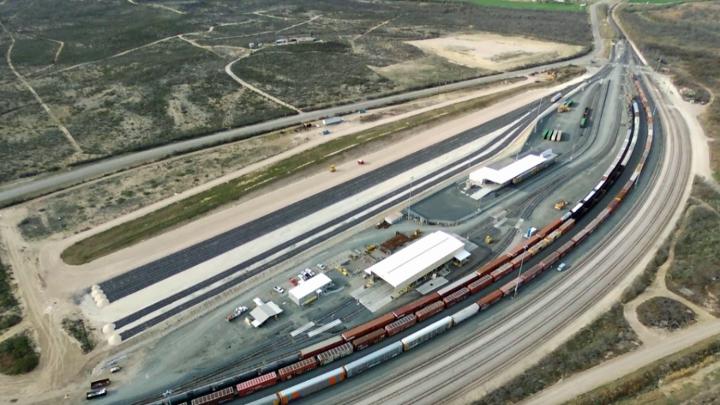
An aerial view of the Maverick Industrial Park in Eagle Pass, ready to serve customers.
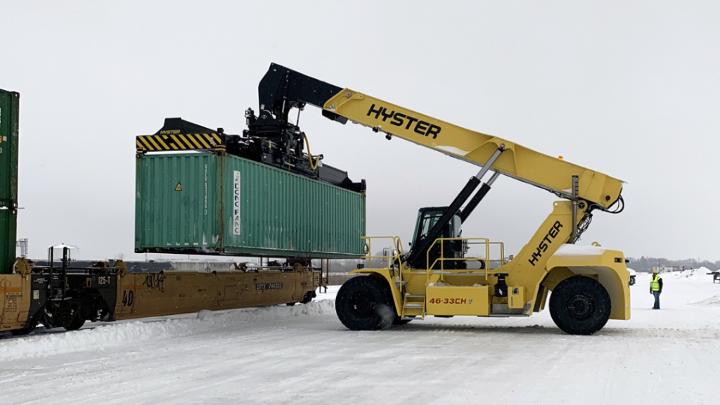
Customers’ containers are loaded for departure from Iowa’s new intermodal terminal.
Generating Opportunity through our Supply Chain
Each year, Union Pacific spends billions of dollars across our network of more than 8,000 suppliers who support our operations with fuel, engineering services, construction materials and more in every one of the 23 states in which we operate. This spending represents a significant portion of the economic impact our business generates.
Union Pacific was the first U.S. railroad to establish a supplier diversity program in 1982. We recognize that strengthening and using businesses owned by minorities, women, LGBT, and veterans contributes to the economic growth and expansion of communities we serve. Union Pacific offers these businesses the maximum opportunity to compete with other suppliers and contractors in the marketplace. We assist in developing and strengthening these business relationships by maintaining active efforts to seek, identify and encourage their participation in our procurement processes.
Union Pacific purchased about $328 million in goods and services from more than 400 diverse suppliers in 37 states. Our spending with diverse suppliers grew an average of 1.3% annually from 2010 to 2019. Approximately 83% of our strategic suppliers reported purchasing goods and services from diverse suppliers, demonstrating their support for our diversity initiative.
Fueling Disaster Recovery Efforts

Kathy Lehne at work in her office, managing a fleet of more than 1,000 service trucks.
Kathy Lehne was 23 years old when she started Sun Coast Resources Inc. in 1985 with just $2,000 and two employees. She wanted to purchase premium petroleum products directly from refiners and provide proven solutions to her customers. Today, Sun Coast is one of the largest woman-owned businesses in Texas and one of the nation’s largest wholesale petroleum marketers.
Headquartered in Houston, Sun Coast is licensed in more than 40 states and operates 18 offices and bulk plant facilities in Texas, Oklahoma and Louisiana. The bulk of its business is focused on providing fuel for disaster relief efforts, which included responding to almost every major hurricane in the U.S. over the past decade. Union Pacific was Sun Coast’s first fuel customer, and we are proud to continue our long-standing relationship purchasing locomotive and non-locomotive fuel. We rely on Sun Coast for delivery services to our facilities across Texas’ major cities.
What's Ahead
Spending to harden our infrastructure, replace older assets and improve safety will be the focus of our 2020 capital investment program. We anticipate spending $2.95 billion, with an additional $150 million for strategic siding extensions, allowing us to operate longer trains and reduce GHG emissions. These sidings will support our efficiency initiatives to increase the number of long trains we can operate in each direction. Union Pacific will continue investing in capacity projects that improve productivity and operational efficiency, including investments to support intermodal operation consolidation in Chicago. PTC spending will focus on interoperability testing and an enhancement to our Energy Management System to help reduce fuel consumption.
